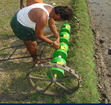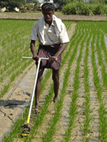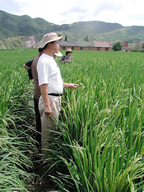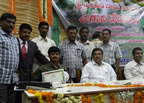Featured Items: MARCH 2012
March 28, 2012
INDIA: Another SRI Modification --
Direct-Seeding with a Drumseeder in Andhra Pradesh
-
 System of
Rice Intensification (SRI) concepts and principles have been adapted to fit the
needs of rice growers as well as the agroecosystem wherever they are tried. As
an "open source" climate-smart innovation, SRI is of course intended to be
modified by the users! While originally developed for irrigated, transplanted
rice, SRI concepts have been adapted to rainfed conditions in Asia and Africa,
for raised
beds in Pakistan, in ground cover rice production
systems in China, and even to other crops such as sugarcane, wheat and vegetables! In today's
feature, we are covering a direct-seeding SRI modification being promoted by
the Rashiya Seva Samithi Acharya Ranga Krishi Vigyan Kendra (RASS-KVK) in
Tirupati,
Chittoor district, Andhra Pradesh, India. RASS-KVK, which started working
with SRI as early as 2003, began experimenting with the drumseeder SRI
adaptation for direct-seeding in 2006; by 2011, 658 farmers are using the
method on 1,220 acres in Chittoor district . The drumseeder is shown at
right.
System of
Rice Intensification (SRI) concepts and principles have been adapted to fit the
needs of rice growers as well as the agroecosystem wherever they are tried. As
an "open source" climate-smart innovation, SRI is of course intended to be
modified by the users! While originally developed for irrigated, transplanted
rice, SRI concepts have been adapted to rainfed conditions in Asia and Africa,
for raised
beds in Pakistan, in ground cover rice production
systems in China, and even to other crops such as sugarcane, wheat and vegetables! In today's
feature, we are covering a direct-seeding SRI modification being promoted by
the Rashiya Seva Samithi Acharya Ranga Krishi Vigyan Kendra (RASS-KVK) in
Tirupati,
Chittoor district, Andhra Pradesh, India. RASS-KVK, which started working
with SRI as early as 2003, began experimenting with the drumseeder SRI
adaptation for direct-seeding in 2006; by 2011, 658 farmers are using the
method on 1,220 acres in Chittoor district . The drumseeder is shown at
right.On February 23, 2012, Nageswar Rao of Madibaka Village, Yerpedu Mandal, received the Best SRI Farmer Award for the Chittoor district of Andhra Pradesh. Rao, the first person to adopt the modified SRI drumseeder method in his area, was presented with the certificate by the A.P. Minister for Mines. In the photo at right, he is shown sitting between Associate Director of Research Dr.Giridhar Krishna and District Collector Sri Salmon Arogya raj.
RASS-KVK began applying SRI concepts and principles to direct seeding for rice as a potential solution to farmers' rice production constraints and to raise paddy productivity. Direct seeding with a drumseeder (shown at left) proved to reduce labor and time requirements through eliminating nursery-raising and transplanting, and resulted in a uniform plant population that matures earlier by 7-10 days. Data comparing the modified SRI method to traditional methods showed the average yield was higher (12%), cultivation costs were lower (by 25%), gross returns were greater (10%), and net returns were much higher (76%) with the direct-seeding.

 A brief
description of the method: The drumseeder is filled with pre-germinated
seeds (left) which are then directly sown (in rows @ 20 cm row-to-row spacing)
in a well-puddled and well-leveled wet field. The light, easy-to-use,
drumseeder reportedly allows one person to sow one hectare in 5-6 hours
compared to 3-4 days of transplanting labor by 30- 40 people as in the
traditional cultivation method. The need for hand weeding is reduced by use of
pre-emergence weedicides coupled with use of a modified conoweeder (right) in
between the rows (from 20 days after seeding) . Up to the panicle initiation
stage, intermittent irrigation is followed by irrigating the field every 2 to 3
days.
A brief
description of the method: The drumseeder is filled with pre-germinated
seeds (left) which are then directly sown (in rows @ 20 cm row-to-row spacing)
in a well-puddled and well-leveled wet field. The light, easy-to-use,
drumseeder reportedly allows one person to sow one hectare in 5-6 hours
compared to 3-4 days of transplanting labor by 30- 40 people as in the
traditional cultivation method. The need for hand weeding is reduced by use of
pre-emergence weedicides coupled with use of a modified conoweeder (right) in
between the rows (from 20 days after seeding) . Up to the panicle initiation
stage, intermittent irrigation is followed by irrigating the field every 2 to 3
days. -
Videos about the direct seeding with the drumseeder and use of a power weeder with direct-seeded rice are available on YouTube. There is also a Telugu language practical booklet for those of you able to read this local language of Andhra Pradesh!
For more details, see the 2012 report by P. Bala Hussain Reddy, S. Sreenivasulu and C. Manohar.
-
Other methods of direct seedling: While direct-seeding of rice is certainly not new and does not always use SRI principles, below are some adaptations of direct seeding that have been inspired by SRI concepts and are able to achieve many of the phenotypic improvements achieved with SRI methods:
- South Sulawesi, Indonesia: SRI direct seeding without the use of a drumseeder in Sadang irrigation scheme of DISIMP (2006)
- Tamil Nadu, India: Direct planting system reported by S. Ramasamy at Tamil Nadu Agricultural University [direct seeding with subsequent thinning that cuts the number of days of labor required per hectare by 40%. Yields were reportedly better than the local drum seeding practice] (2006)
- Sri Lanka: System of thinning direct-seeded rice with motorized weeder developed by Ariyatne Subasinghe
March 12, 2012
CHINA: Research Articles about the
System of Rice Intensification (SRI) in China Now Available on the SRI-Rice
Website
-

For many researchers and others who follow the science behind the System of Rice Intensification, parts of the SRI story unfolding in China have remained somewhat of a mystery. Not only are there many SRI adaptations in the largest country in the world, but the scientific literature on what is being discovered about SRI in China has been scattered throughout English and Chinese databases, academic institutions, conference proceedings, etc.... and much of it, of course, is in Chinese. The SRI-Rice Center at Cornell has been collecting articles about SRI-related research carried out over the past decade in China and we have made (many of) them accessible from our website in a variety of formats.
While many the articles we found are written entirely in Chinese, we have translated the titles, authors and abstracts of many of the articles that did not contain English metadata, in order to make them accessible to a wider audience. As of March 2012, articles on Chinese SRI research are available online in 1) a chronological bibliography and 2) a searchable SRI-China RefWorks database. The bulk of the 86 articles listed in both sources are accessible online. While full text versions of much of the peer-reviewed literature unfortunately cannot be accessed without subscription, the abstracts of most are available through our SRI-China RefWorks database. (Click on the magnifying glass icon to see the extended view of the metadata, which includes abstracts, urls and other information).
While we still have a ways to go to access some of the offline scientific literature about SRI in China, we hope you will find the 86 articles listed in our searchable database and on our static bibliography useful!
--- The SRI-Rice Chinese Research Team: Devon Jenkins, Norman Uphoff, Erika Styger, Lucy Fisher, Weifen Qiu, Zhoucen Feng and Renling Zhang
(Shown at right is Dr. Zhu Defeng, who co-authored 13 of the articles in the database. He is a senior scientist and deputy director at China National Rice Research Institute, Hangzhou. In this photo, he is making a field visit to the farm of Nie Fu-qu, Bu Tou village, Tien Tai county, Zhejiang province.)
For more information on the System of Rice Intensification in China, see our China page.


